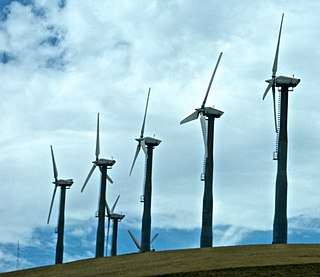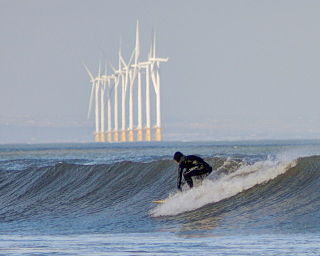
The United Kingdom is the best location for wind power in Europe and one of the best in the world. By 2023, the UK had over 11 thousand wind turbines with a total installed capacity of 28 gigawatts (GW): 14 GW onshore and 14 GW offshore, the sixth largest capacity of any country. Wind power generated about 25% of UK electricity, having surpassed coal in 2016 and nuclear in 2018. It is the largest source of renewable electricity in the UK.

Wind power became a significant energy source within South Australia over the first two decades of the 21st century. In 2015, there was an installed capacity of 1,475 MW, which accounted for 34% of electricity production in the state. This accounted for 35% of Australia's installed wind power capacity. In 2021, there was an installed capacity of 2052.95 MW, which accounted for 42.1% of the electricity production in the state in 2020.

The Altamont Pass wind farm is located in the Altamont Pass of the Diablo Range in Northern California. It is one of the earliest wind farms in the United States. The first wind turbines were placed on the Altamont in the early 1980s by Fayette Manufacturing Corporation on land owned by cattle rancher Joe Jess. The wind farm is composed of 4930 relatively small wind turbines of various types, making it at one time the largest wind farm in the world in terms of capacity. Altamont Pass is still one of the largest concentration of wind turbines in the world, with a capacity of 576 megawatts (MW), producing about 125 MW on average and 1.1 terawatt-hours (TWh) yearly. They were installed after the 1970s energy crisis in response to favorable tax policies for investors.

Te Rere Hau is a wind farm owned and operated by New Zealand Windfarms Ltd. It is situated on the Tararua Ranges, approximately 11 km east of Palmerston North in New Zealand.

Wind power is the fastest-growing renewable energy technology in Scotland, with 11,482 megawatts (MW) of installed wind power capacity by Q1 2023. This included 9,316 MW from onshore wind in Scotland and 2,166 MW of offshore wind generators.
Oriel Wind Farm is a proposed offshore wind farm in the northwestern Irish Sea. The project is associated with Oriel Windfarm Limited, a privately owned Irish renewable energy company.

Whitelee Wind Farm is a windfarm on the Eaglesham moor in Scotland. The main visitor centre is located in East Renfrewshire, but the majority of turbines are located in East Ayrshire and South Lanarkshire. It is the largest on-shore wind farm in the United Kingdom with 215 Siemens and Alstom wind turbines and a total capacity of 539 megawatts (MW), with the average of 2.5 MW per turbine. Whitelee was developed and is operated by ScottishPower Renewables, which is part of the Spanish company Iberdrola.

In 2021 France reached a total of 18,676 megawatts (MW) installed wind power capacity placing France at that time as the world's seventh largest wind power nation by installed capacity, behind the United Kingdom and Brazil and ahead of Canada and Italy. According to the IEA the yearly wind production was 20.2 TWh in 2015, representing almost 23% of the 88.4 TWh from renewable sources in France during that year. Wind provided 4.3% of the country's electricity demand in 2015.

Askam and Ireleth is a civil parish close to Barrow-in-Furness in Westmorland and Furness, Cumbria, England. Historically part of Lancashire, it originally consisted of two separate coastal villages with different origins and histories which, in recent times, have merged to become one continuous settlement. In the 2001 census the parish had a population of 3,632, reducing at the 2011 census to 3,462.

The Barrow Offshore Wind Farm is a 30 turbine 90MW capacity offshore wind farm in the East Irish Sea approximately 7 kilometres (4.3 mi) south west of Walney Island, near Barrow-in-Furness, Cumbria, England.

Scout Moor Wind Farm is the second largest onshore wind farm in England. The wind farm, which was built for Peel Wind Power Ltd, produces electricity from 26 Nordex N80 wind turbines. It has a total nameplate capacity of 65 MW of electricity, providing 154,000 MW·h per year; enough to serve the average needs of 40,000 homes. The site occupies 1,347 acres (545 ha) of open moorland between Edenfield, Rawtenstall and Rochdale, and is split between the Metropolitan Borough of Rochdale in northern Greater Manchester and the Borough of Rossendale in south-eastern Lancashire. The turbines are visible from as far away as south Manchester, 15–20 miles (24–32 km) away.

Wind power in Illinois provided nearly 10% of the state's generated electrical power in 2020 powering 1,231,900 homes. At the end of 2020, Illinois had 6,300 megawatts (MW) of wind power installed, ranking fifth among states for installed wind turbine capacity. An additional 1,100 MW of wind power was under construction across the state at the end of 2020.

The Beatrice Offshore Wind Farm now known as Beatrice Offshore Windfarm Ltd (BOWL) project, is an offshore wind farm close to the Beatrice oil field in the Moray Firth, part of the North Sea 13 km off the north east coast of Scotland.

Coal Clough Wind Farm is one of the oldest onshore wind farms in England. The wind farm, which was built for Scottish Power, produced electricity from originally 24 Vestas WD34 wind turbines. It had a total nameplate capacity of 9.6 MW of electricity, enough to serve the average needs of 5,500 homes. It is situated near Burnley, Lancashire in the parish of Cliviger, near Coal Clough Farm, on the edge of Stiperden Moor in the South Pennines. For a few weeks it was the largest wind farm in the UK, until the much larger Penrhyddlan and Llidiartywaun wind farms in Powys, Wales overtook it. It narrowly remained the largest in England until Coldham opened in Cambridgeshire in November 2005. The record was then taken yet again by Scout Moor Wind Farm 7 miles (11 km) to the south west until May 2009 where Whitelee Wind Farm took and now holds it with 215 units with a total output capacity of 539 Mw. In 2009 Scottish Power announced plans to replace the existing turbines with eight 2 MW units with an estimated maximum height 110 metres (361 ft).

Teesside Wind Farm, or alternatively referred to as Redcar Wind Farm, is a 27 turbine 62 MW capacity offshore wind farm constructed just to the east of the mouth of the River Tees and 1.5 km north of Redcar off the North Yorkshire coast, in the North Sea, England.

Den Brook Wind Farm is a windfarm in Devon, England. The windfarm is located 2 kilometres (1.2 mi) south-east of North Tawton and 2.5 kilometres (1.6 mi) south-west of Bow, and comprises nine 2 MW wind turbines, each 120 metres (390 ft) high. Developer Renewable Energy Systems (RES) received planning consent for the project in December 2009, following a long planning process which included two public inquiries and a judicial review.
REG WindPower is a renewable energy company, in the United Kingdom.
Dogger Bank Wind Farm is a group of offshore wind farms under construction 125 to 290 kilometres off the east coast of Yorkshire, England in the North Sea. It was developed by the Forewind consortium, with three phases envisioned - first phase, second phase and third phase. In 2015 the third phase was abandoned, while the first and second phases were granted consent. It is expected that the Dogger Bank development will consist of four offshore wind farms, each with a capacity of up to 1.2 GW, creating a combined capacity of 4.8 GW.
The European Offshore Wind Deployment Centre (EOWDC), also known as the Aberdeen Bay Wind Farm is an offshore wind test and demonstration facility located around 3 kilometres off the east coast of Aberdeenshire, in the North Sea, Scotland. It was developed by the European Offshore Wind Deployment Centre consortium. The scheme is relatively small - it consists of 11 wind turbines with an installed capacity of 93.2 megawatts. It is located between Blackdog and Bridge of Don near Aberdeen. First power was generated in July 2018, with full commissioning following in September 2018.

The East Anglia Array is a proposed series of offshore wind farms located around 30 miles off the east coast of East Anglia, in the North Sea, England. It has begun with the currently operational East Anglia ONE, that has been developed in partnership by ScottishPower Renewables and Vattenfall. Up to six individual projects could be set up in the area with a maximum capacity of up to 7.2 GW. The first project, East Anglia ONE at 714 MW, received planning consent in June 2014 and contracts in April 2016. Offshore construction began in 2018 and the project was commissioned in July 2020. It is expected to cost £2.5 billion.

















